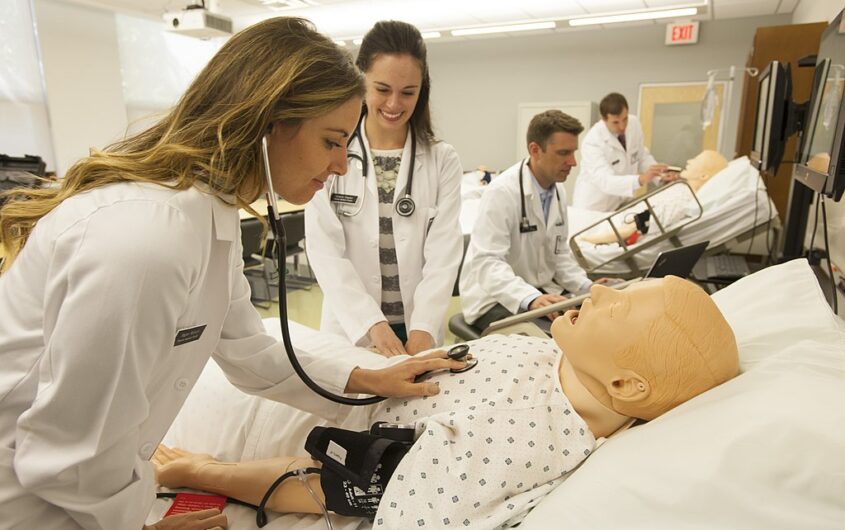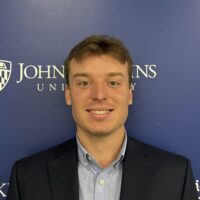
Ohio Dominican via Wikimedia Commons
Addressing Germany’s Medical Personnel Shortage

Thomas Protzman
Thomas Protzman is a Halle Foundation research intern at AGI in fall 2024. He is pursuing a master's degree in International Affairs with a concentration in Human Rights and Global Governance at the Hertie School in Berlin and is currently on academic exchange at the Elliott School of International Affairs at George Washington University. He spent three years in Vienna, completing a teaching fellowship with Fulbright Austria. He earned his undergraduate degree in History from Denison University and studied for a semester at the Ruprecht-Karls Universität in Heidelberg, Germany. Additionally, he brings experience from his time as an intern for U.S. Senator Sherrod Brown. Thomas is committed to strengthening institutional ties and fostering collaborative leadership in the transatlantic sphere. He has a wide range of research interests, including climate change, populism, and institutional trust.
The Untapped Potential of Physician Assistants
Germany is grappling with a significant shortage of medical personnel that is likely to be exacerbated by an aging population of doctors and increasing demand for healthcare services. The numbers are deeply troubling, especially in rural areas. Over 36 percent of current general practitioners are over 60 years old, and in the next three years, it is estimated that their imminent retirement will lead to the closure of five to eight thousand doctors’ practices. Currently, 85 percent of German doctors are working full-time, down from 98 percent in 2009. 40 percent of healthcare jobs vacated during the COVID-19 pandemic remain unfilled today, and the physicians that remain are spending more of their working time on administrative tasks and less on direct patient care. Of those physicians still working, 35 percent consider themselves likely to leave their role in the next five years. Some respondents hoped to switch careers in favor of jobs in consulting, teaching, or the pharmaceutical and biotech industries.
Contentious Proposals
With Germany in such desperate need of more medical professionals, a number of solutions have been proposed, ranging from opening more slots in medical schools to recruiting foreign doctors. There are critical divides on all proposed solutions. The ongoing debates between leading professional associations like the Marburger Bund (Association of German Doctors) and the Medizinischer Fakultätentag (MFT, Medical Faculty Association) over the expansion of medical school slots is one example of the divide in opinions on Germany’s healthcare strategy. The Marburger Bund, representing doctors, advocates for a significant increase in medical school capacities to counteract the impending shortage of physicians as the Baby Boomer generation retires. The MFT has expressed reservations, emphasizing that expanding student numbers too quickly could compromise the quality of medical education. They argue that without adequate resources and infrastructure, a rushed expansion could produce underprepared doctors, ultimately harming patient care. Given the urgency of the situation, there is insufficient time to train a new generation of physicians before the current workforce diminishes to critical levels. Without immediate action, the risk of a significant shortage becomes increasingly real, jeopardizing healthcare delivery across the nation. Strategic measures are essential to ensure that the medical workforce can be maintained and enhanced considering impending retirements.
Immigration might provide a short-term solution, yet it brings its own challenges. The Marburger Bund has opposed tax incentives for foreign specialists for fear of disadvantaging German specialists and expressed concerns about the ethics of recruiting from developing countries that may require their medical professionals’ services even more than Germans do. Additionally, bureaucratic hurdles have severely slowed the process of licensing for immigrant doctors; since the Russian invasion of Ukraine in 2022, only about 10 percent of the 1,600 Ukrainian doctors arriving have been fully licensed to practice. To be licensed, foreign doctors must get their credentials translated and pass a medical German language exam before having their foreign-earned medical degree declared equivalent to a German one. Each of Germany’s sixteen federal states has its own set of standards.
Public perception and acceptance of foreign doctors can also pose barriers. Research indicates that some patients may express reluctance to receive care from foreign-trained physicians, often due to preconceived notions about their capabilities. Recent studies have shown that many migrant healthcare professionals report experiencing discrimination related to their race and ethnicity. This can lead to reduced job satisfaction among immigrant doctors, potentially resulting in higher turnover rates and further exacerbating the shortage.
PAs in Europe: The Dutch Model
As pressures mount on the German healthcare system, the role of Physician Assistants (PAs) can become vital. Originally developed in the United States in the 1960s, the PA profession has experienced a 76 percent growth rate in the last decade, and American PAs see approximately 10.4 million patients per week. It has since expanded internationally, adapting to various healthcare needs across different countries. PAs were introduced in the Netherlands in 2000 and have since proven to be integral to improving care efficiency and patient access. After recognizing PAs as a profession in 2012, the Dutch parliament and Senate agreed in 2017 to give PAs full independence in diagnosing, initiating treatment, and performing a wide range of medical procedures including endoscopies and catheterizations, as well as neuro cardiothoracic surgical procedures. This decision has proven correct. Research has found that Dutch PAs especially performed new tasks or tasks for which there was previously not enough capacity, such as making rounds, updating case histories, or other administrative tasks, and their inclusion seemed to lead to better patient experiences. By assuming these various clinical tasks and working autonomously under supervision, PAs allowed said physicians to focus on more complex cases. Further research has indicated that Dutch patients are satisfied with the care delivered by PAs and that PAs contribute to cost savings due to their reduced labor cost and the efficiency that they add to the workplace. In interviews, Dutch medical doctors and hospital managers stated that the deployment of PAs enhanced the quality of patient care and improved the efficiency of the medical service.
Following the successful implementation of the profession in the Netherlands, PAs have begun to establish a presence in northwestern Germany, reflecting a growing recognition of their potential to alleviate some of the pressures facing the healthcare system. PAs tend to be young women, as survey data shows that 77 percent of respondents identify as women and 86 percent are below the age of thirty-five. Although the integration of PAs into German healthcare at the national level is still in its formative stages, advocacy groups like the Deutsche Gesellschaft für Physician Assistants e.V. (German Society for Physician Assistants) are emerging to support and promote the role of PAs across the country. These advocacy groups aim to enhance the visibility of the PA profession, provide resources for training and certification, and engage in efforts to shape policy that will facilitate the broader adoption of the PA role within the German healthcare system. Thus far, PAs have been well-received. Recent studies indicate a generally positive perception of PAs in Germany, particularly regarding workload relief and bridging the gap between healthcare professionals.
While the integration of PAs holds significant promise for alleviating Germany’s medical personnel shortage, some concerns warrant consideration. Critics argue that a PA education may not possess the same depth of training as physicians, raising questions about the quality of care provided, particularly in complex medical situations. There is resistance from some healthcare professionals who are unfamiliar with the PA role, fearing it could undermine their authority or lead to job displacement. However, there is substantial evidence demonstrating their positive impact on healthcare delivery in both the Netherlands and Germany. Research consistently shows that PAs can significantly enhance patient care while maintaining high levels of satisfaction among both patients and healthcare providers. Nevertheless, existing regulatory frameworks may limit the scope of practice for PAs, potentially hindering their effectiveness in delivering care. Addressing these concerns through education and clear regulatory guidelines will be crucial to ensuring the successful integration of PAs into the healthcare system.
The Path Forward
In the Netherlands, the introduction of Physician Assistants marked a significant shift in healthcare delivery. These professionals have become essential to improving patient access and managing care efficiently, working autonomously under the supervision of physicians and possessing full prescribing authority. Their role has proven particularly beneficial in primary care settings, where they provide continuity of care and increase patient contact time, ultimately enhancing the overall quality of healthcare services. The integration of PAs in northwestern Germany is still evolving, but there is growing recognition of their potential to alleviate Germany’s physician shortages. Most of the federal states are training and using physician assistants, but not in their full capacity. By learning from the Dutch experience and updating regulatory frameworks to allow for the wider utilization of PAs, Germany could significantly enhance its healthcare system and address the pressing challenges posed by its aging medical workforce.






